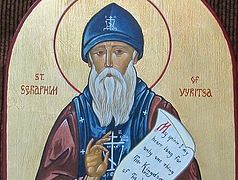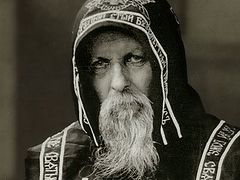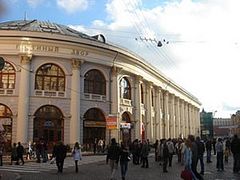On April 3 the Holy Church commemorates the Venerable Seraphim of Vyritsa, who before the Revolution was a prosperous merchant, owned luxury fur shops in St. Petersburg, did business with both the royal court and European companies, and after the Revolution became a monk. How did his relationship with money develop and can holy rich men still be found in our day?
We know about many saints who came from wealthy families: the martyrs of both sexes (the Greatmartyr Demetrius of Thessaloniki, the Holy Martyrs Tatiana, Irene, and Barbara); the venerable fathers (Sts. John Damascene, Simeon the New Theologian); the righteous (Sts. Philaret the Merciful, Alexis the Man of God). Church history knows a host of right-believing princes, kings and other rulers who made generous contributions to their neighbors (it is known that Holy Equal-to-the-Apostles Vladimir, the Baptizer of Russia, organized regular Sunday feasts for the poor). The “financial situation” of saints is usually mentioned only once, namely at the beginning of their Lives—for example, “He/she was descended from a noble and wealthy family”.
In some cases saints developed “special relations” with their riches: Some of them used their wealth to serve God and people, while others strove to flee from any worldly riches and become absolutely penniless.
St. Seraphim of Vyritsa
The name of the holy elder Seraphim of Vyritsa is known throughout the Orthodox world. He is venerated as a great ascetic and wonderworker. Meanwhile, before he took up monasticism Vasily Nikolaevich Muraviev (St. Seraphim’s secular name of) had been a successful businessman.
Vasily was born on March 31, 1866, in a village of the Yaroslavl province. When the boy was ten years old his father died, and Vasily was left with his sick mother and very little sister. Thus he became the only breadwinner in his family. A man from the same village who worked as a senior assistant at one store of St. Petersburg took Vasya [a diminutive form of the Russian name Vasily] with him, made him his aid, promising his (Vasily’s) mother to bring him “into society”. In St. Petersburg Vasily first worked as an errand-boy at a store of Gostiny Dvor [literally: “Guests’ Court”—the capital’s major center of trade at that time]. With time, seeing the boy’s abilities and diligence, his employers charged him with more serious and difficult jobs.
 Vasily Nikolaevich Muraviev
Vasily Nikolaevich Muraviev The adolescent remained to work in the store and his work was very successful. At the early age of seventeen he became a senior store assistant. This indicated that young Vasily had a special talent as a merchant because at that time it would take somebody at least ten years to become a senior shop assistant.
In 1890, Vasily married a young lady from his village. Her story was similar to that of Vasily: she had longed for monastic life from her childhood like him, but an experienced, clairvoyant schema-nun advised her to live in the world and permitted her to receive the tonsure only after many years of trials and tribulations of life in the world.
After Vasily’s wedding, his master endowed him with a large sum of money to help his favorite worker to start his own business. And in 1892, with his support Vasily Nikolaevich Muraviev opened his company that procured and sold furs. The products were mostly shipped abroad: to Germany, the UK, France.
Vasily Nikolaevich was a very talented entrepreneur. He was making good progress in his business, yet the purpose of his trading activities was not accumulating capital but helping the Church and his neighbors. The young businessman studied much; in 1895 he became a full member of the Society for Dissemination of Commercial Knowledge in Russia, and went to the Higher School of Commerce that was founded at the Society.
The Society’s activities had a patriotic nature. The businessmen from among the Society’s members cared not only about the success of their business but also about the economic progress of Russia. At that time many foreign entrepreneurs (like Henry Ford) were learning from Russian merchants and industrialists. Russia dictated world price levels for many kinds of raw materials, industrial commodities and agricultural products, while the gold ruble became one of the hardest currencies in the world…
Helping some churches and monasteries, Vasily Nikolaevich also donated to the maintenance of almshouses, the largest of which was situated at Moskovsky Avenue (in 1918-1950—Mezhdunarodny Avenue) attached to the Resurrection Novodevichy (“New Maiden”) Convent.
The Muravievs had a tradition of hosting sumptuous banquets for the poor after the Liturgy on major Church festivals. Vasily Nikolaevich would deliver a short speech after the prayer, speak about the meaning of the feast and then greet all those present at the dinner.
In 1905, Vasily Nikolaevich Muraviev became a full member of Yaroslavl Charitable Institution—one of the largest organizations of this kind in Russia. The Institute’s permanent members included many outstanding hierarchs and figures of the Russian Orthodox Church—for example, St. John of Kronstadt.
Years passed. Vasily Nikolaevich Muraviev continued to live in the world—he prayed much, worked much, performed acts of charity, and secretly made numerous donations. Eventually 1917 came. Many wealthy people transferred their money abroad and tried to flee the country, yet this alternative did not exist for Vasily Nikolaevich who loved his motherland dearly and was ready to share his people’s misfortunes. On losing his business the future elder began to study writings of the Holy Fathers, rules of monasteries, liturgical books, and to pray fervently.
In 1920, Vasily Nikolaevich and his wife Olga Ivanovna separated by mutual consent and took monastic vows, as had been predicted many years before. Olga Ivanovna entered the Resurrection Novodevichy Convent in Petrograd [the name of St. Petersburg between 1914 and 1924] as a novice nun and Vasily Ivanovich joined the St. Alexander Nevsky Lavra. The former spouses donated all their possessions to monasteries and convents. 40,000 rubles in gold were given to the Lavra alone.
In the same year, Vasily and Olga were tonsured. Thus the story of a righteous fur merchant ended and the story of the great elder Seraphim of Vyritsa began. But that is another story entirely…




